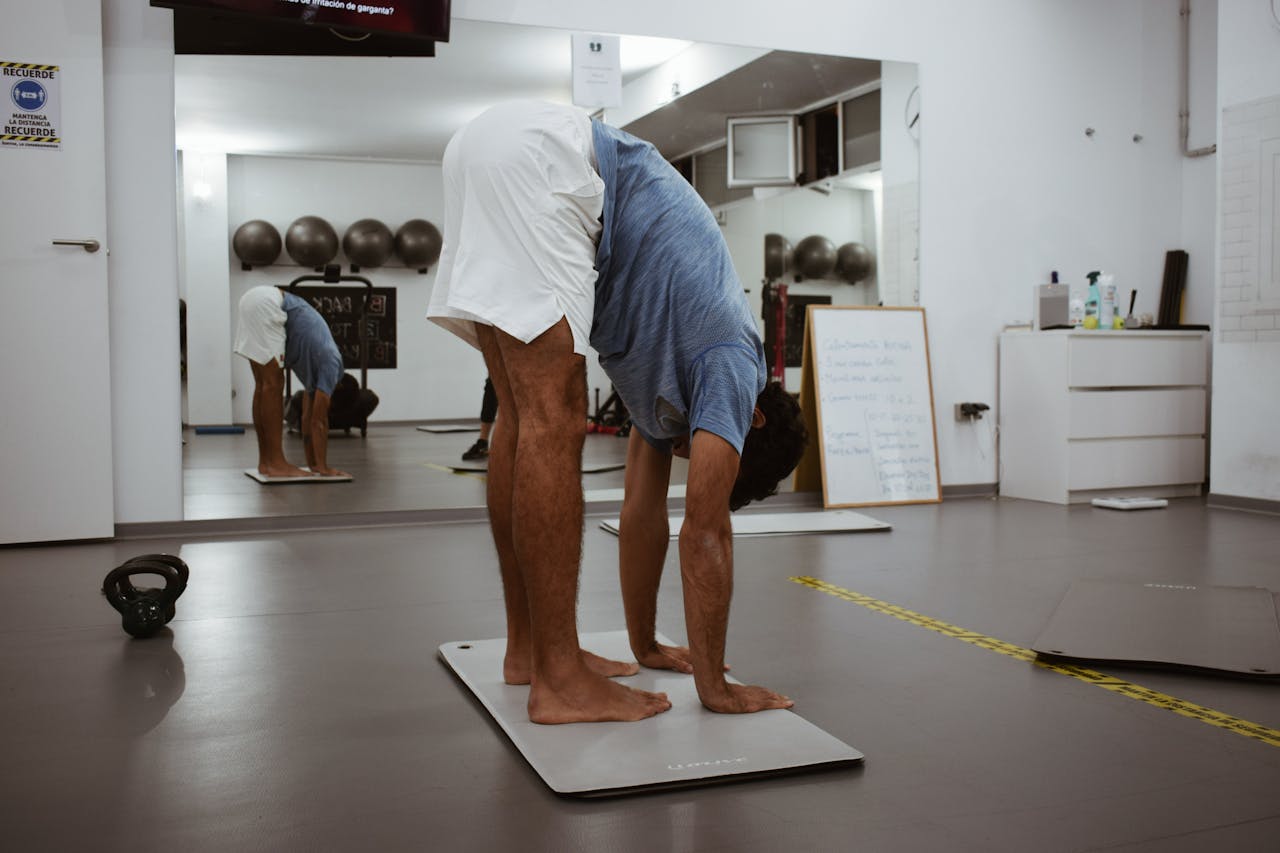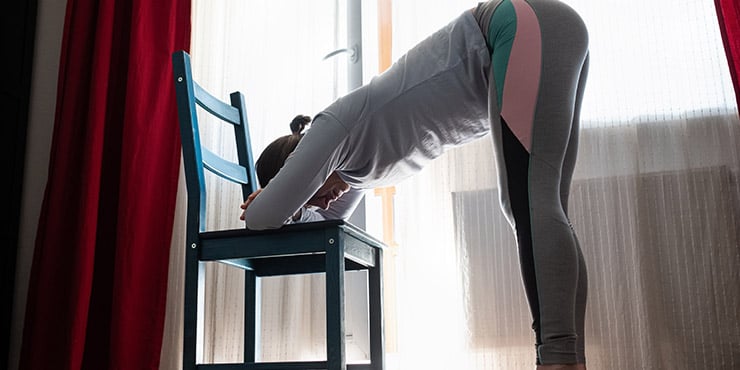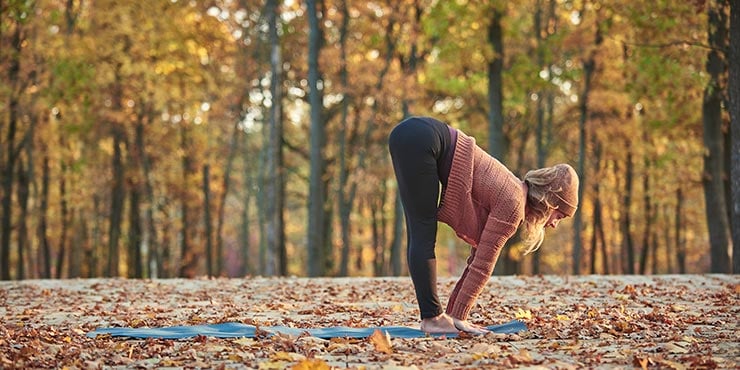
Table of Contents
Ardha Uttanasana, also known as Half Forward Fold, is a yoga pose that stretches the hamstrings and lengthens the spine. It is a variation of Uttanasana (Forward Fold) and is a transition pose in yoga practice.
The Half-Forward Bend Yoga Pose
Ardha Uttanasana, also called Half Forward Fold or Half Intense Stretch Pose, combines forward folding at the hips and backward bending of the spine and upper body. In this position, the chest lifts forward, and the head looks straight ahead. This pose is often part of Ashtanga Yoga's Sun Salutations A and B, but it can also be standalone.
Benefits of Ardha Uttanasana
Standing half forward bend pose offers several benefits for the whole body, including:
- Develops flexibility: Stretches tight hamstrings and calf muscles, improving leg flexibility.
- Improves Posture: Lengthens the spine, promoting good posture and reducing stiffness in the back.
- Increases Strength: Strengthens the core muscles, including the abdominals and lower back, improving stability and balance.
- Stimulates the organs: This pose stimulates the abdominal organs in the lower belly, aiding digestion and promoting detoxification.
- Activates the Manipura (solar plexus) chakra: activation of the Manipura chakra can help to build self-esteem and increase motivation, making Ardha Uttanasana a great pose to practice for those seeking to strengthen their sense of inner strength and confidence.
- Relieves anxiety and stress: Helps to calm the mind and relieve stress and anxiety.
Contraindications
Although Ardha Uttanasana is generally considered a safe yoga pose for most people, there are a few contraindications to keep in mind, including:
- Back injuries: Individuals with a back injury, especially those involving the lower back, should avoid Ardha Uttanasana.
- High blood pressure: The pose involves a forward bend, which can increase blood pressure in some individuals.
- Pregnancy: Pregnant women should avoid Ardha Uttanasana, especially during the second and third trimesters, as it can put pressure on the abdomen.
- Hamstring injuries: People with injured hamstrings should avoid Ardha Uttanasana as it involves a forward bend that can aggravate the injury and cause further damage.
- Neck Injury: People with neck injuries should avoid Ardha Uttanasana as it involves a forward fold with the head facing down, which can put pressure on the neck and potentially worsen the injury.
It is always important to consult with a qualified yoga instructor or healthcare provider before attempting any new yoga pose, especially if you have any pre-existing medical conditions or injuries.
Step-By-Step Instructions
Here are the step-by-step instructions for Ardha Uttanasana (Half Forward Fold Pose):
- Start in Tadasana (mountain pose) with feet hip-distance apart and hands resting at the sides of the body.
- Inhale and raise the arms overhead, lengthening the spine.
- Exhale and fold forward from the hips, keeping the upper body parallel to the floor.
- Place the hands on the thighs, shins, or floor in front of the feet.
- Keep the knees either straight or slightly bent, depending on flexibility, and avoid locking the knees.
- Lift the chest and gaze forward, lengthening the spine.
- To deepen the stretch, lift the sit bones and extend through the back of the legs.
- To come out of the pose, inhale and lift halfway up with a long spine, or come all the way up to standing.
- Exhale and release the arms to the sides of the body.
Note: If there is any discomfort or strain in the neck, keep the gaze down towards the floor rather than forward. It is also important to avoid rounding the spine in this pose, as this can lead to injury.
Optional Props
 Those with limited hamstring flexibility can benefit from using a yoga block, pair of blocks, or a sturdy chair during their Ardha Uttanasana practice. To maximize the effectiveness of the blocks, they should be beneath the shoulders. If using a chair, position it close to the fronts of the legs to maximize its usefulness.
Those with limited hamstring flexibility can benefit from using a yoga block, pair of blocks, or a sturdy chair during their Ardha Uttanasana practice. To maximize the effectiveness of the blocks, they should be beneath the shoulders. If using a chair, position it close to the fronts of the legs to maximize its usefulness.
Individuals can place the balls of their feet on a folded blanket to deepen the hamstring stretch. This will create a slight incline and help to lengthen the back of the legs. Listen to the body and never force any stretches or movements beyond what feels comfortable.
Exploring Its Sanskrit Roots
Uttanasana is a yoga pose that translates to "deliberate lengthening" in Sanskrit and is also commonly known as Standing-Forward-Fold. This pose involves standing with the ankle joints touching, straight legs, and bending forward with both hands flat on the floor next to the feet. On the other hand, Ardha Uttanasana, also called Half Forward Fold, involves a half-forward bend either by bending halfway forward or at the hips while arching the spine backward.
Improving Spinal Awareness
Practicing Ardha Uttanasana can help individuals better understand the spine and its relationship to the hips. Concentrating on feeling and controlling the spine's muscles is crucial rather than forcing oneself into a specific position without proper awareness.
Before practicing Ardha Uttanasana, Parsvottanasana can serve as a valuable warm-up, particularly when performed without clasping the hands in a prayer pose behind the back. This will help prepare the body for the deeper hamstring stretch of Ardha Uttanasana.
It is essential to avoid putting too much weight on the heels and losing proper form while practicing Ardha Uttanasana. To develop a sense of correct weight distribution, individuals can practice the pose against a wall. This will help maintain proper alignment and prevent the body from collapsing backward. Practitioners should remember to move slowly and mindfully and to always listen to their bodies.
Practicing Resisted-Hip-Rotation
Practicing resisted hip rotation enables individuals to explore their legs' internal and external rotation. To begin, one should bend forward with their feet hip-width apart. In this position, individuals can rest their hands on the floor, shins, yoga blocks, or the edge of a chair. By activating and releasing either of these two internal and external leg rotation actions, individuals can observe the change in sensation in their hips, knees, and inner thighs.
Once comfortable with these movements from this posture, individuals can try them while performing a standing forward fold. During a half-standing forward fold with feet together, keeping core elements, such as abdominal muscles and front torso, engaged for added support throughout the pose is essential. It is important to maintain correct alignment to ensure proper postural alignment during the movement.
Practicing resistive hip rotation ultimately leads to greater flexibility and better movement patterns in the body that are more efficient and injury-free.
Practicing Upper Body Control
Learning to feel and activate the spinal erectors is essential for a backward spinal extension. One preparatory pose that helps practice this is Shalabasana, also known as the locust pose. Additionally, practicing bending the spine backward while standing or sitting upright can help individuals gain better control over their torso in Ardha Uttanasana. Here are some additional preparatory poses to help prepare the body for Urdha Uttanasana:
Spinal Back-bending while Standing Upright
To perform this exercise, individuals should stand upright with their knees slightly bent and feet hip-width apart. It is essential to focus on keeping the shoulders relaxed throughout the movement. Instead of deliberately drawing the shoulder blades inward when lifting the chest, individuals should work on maintaining a relaxed shoulder position.
Focusing on the Sternum
To perform this exercise, individuals should focus on their sternum and carefully lift it upwards. As they do this, they will notice their sternum moving away from their pubic bone, causing their abdomen to extend. It is essential to be aware of the feeling at the front of the hip bones and take note of the sensation as the belly expands.
When gently lowering the sternum, individuals should strive for the greatest range of movement possible, even allowing themselves to slump down if desired. Throughout the movement, it is important to be conscious of the changes in sensation along the front of the waist.
Performing these movements a few times can help individuals gain an understanding of them and the sensation associated with them.
Focusing on the back of the rib cage
To focus on the back of the body, individuals should perform the same actions as before, lifting and lowering the sternum. They should attempt to feel the backs of their ribs and observe how they move during this movement. While lifting, individuals may feel their ribs pull downwards. Conversely, when lowering the sternum, there may be a feeling of the ribs rising.
By paying attention to these movements and sensations, individuals can better understand their body and how it moves. This increased awareness can help improve posture and alignment and prevent injury during physical activity.
Focusing on the spine
To direct focus on the back of the spine, individuals should lift their sternum as high as possible and attempt to detect any muscular sensation on either side of the spinal column. It may be helpful to slightly resist the chest from rising further up to better feel the back muscles.
Once individuals have lifted and relaxed their chest, they should be aware of the muscles at the rear of their spine relaxing. This sensation is from the spinal erectors, providing a downward pull on the back.
These exercises can begin while kneeling, sitting cross-legged, or seated in a chair to become familiar with how these muscles work and the sensation when the waist elongates. Once individuals understand how these muscles work, they can apply the same feeling in Ardha Uttanasana.
Integrating Spinal Awareness into Half Forward Bend
Now that individuals are aware of the sensations when curving the back upward, they can apply this knowledge while performing a standing forward bend. To begin, individuals should disregard previously practiced hip activations and curve their spine backward. If necessary, they can use the assistance of their hands on their legs or blocks to ensure safe execution.
By applying this knowledge, individuals can improve their posture and alignment during a standing forward bend. They can also prevent injury by ensuring the safe execution of the pose. As individuals become more comfortable with this movement, they can add previously practiced hip activations to further enhance their practice.
Adding hip muscle control
Once individuals have a feel for the posture, they can attempt to activate their hips before curving their back backward. Working with resisted internal hip rotation, they can detect the sensation of their sitting bones spreading and lifting. They should move their chest forward while elongating their waist and simultaneously pulling the back ribs towards their buttocks. Additionally, they should direct their ears away from their shoulders to experience an extended back of their neck.
Individuals can position their hands on the front of their legs or higher up on the yoga blocks if needed. They should hold this stance for a few breaths, then let go and wait briefly before repeating. When starting with feet at hip-width apart, individuals should try with feet together too. This will help them to work on their balance and enhance their practice. With consistent practice, individuals can improve their posture, alignment, and overall well-being.
Working towards keeping the hands on the floor
 To perfect Ardha Uttanasana as part of the Ashtanga Yoga Poses Sun Salutation yoga sequence, the practitioner should focus on arching their spine while keeping their hands (or fingertips) connected to the ground. Using resisted hip rotation or other muscle control techniques can help achieve this by increasing the front tilt of the pelvis gradually. The key is to focus on curving the back while keeping the hands in contact with the floor.
To perfect Ardha Uttanasana as part of the Ashtanga Yoga Poses Sun Salutation yoga sequence, the practitioner should focus on arching their spine while keeping their hands (or fingertips) connected to the ground. Using resisted hip rotation or other muscle control techniques can help achieve this by increasing the front tilt of the pelvis gradually. The key is to focus on curving the back while keeping the hands in contact with the floor.
It may be helpful to practice this pose outside of Sun Salutations. This can allow the practitioner to work on the necessary muscle control and increase flexibility in the relevant areas. With regular practice, it is possible to perfect Ardha Uttanasana and achieve a smooth and graceful flow in Sun Salutations.
Moving between uttanasana and ardha uttanasana
To finish the practice, alternate between Uttanasana and Ardha Uttanasana with slow and deliberate movements. Observe how the pelvis moves during the transition. When moving from Uttanasana to Ardha Uttanasana, tilt the pelvis slightly backward while curving the back forward. When transitioning from Ardha Uttanasana to Uttanasana, tilt the pelvis forward while bending the spine backward. Focus on maintaining control and mindfulness throughout the movement.
Noticing knee rotation
The muscles extending from the hip bones to the knees are essential in controlling knee rotation. Therefore, paying attention to the movement of the knees as the pelvis shifts can be beneficial. Developing greater awareness and control over the knees can support yoga pose progress. Focusing on how the knees turn inward or outward as the pelvis changes can help increase awareness and control.
Synchronizing movement and breath
As the movements become more familiar, they can integrate with the breath. Generally, exhaling is natural when tilting the pelvis backward and arching the spine forwards, while inhaling should be done when bending the spine back.
References
Standing Half Forward Bend (Ardha Uttanasana)
How To Do an Uttanasana Yoga Pose
Disclaimer
The contents of this article are provided for informational purposes only and are not intended to substitute for professional medical advice, diagnosis, or treatment. It is always recommended to consult with a qualified healthcare provider before making any health-related changes or if you have any questions or concerns about your health. Anahana is not liable for any errors, omissions, or consequences that may occur from using the information provided.

By: Anahana
The Anahana team of researchers, writers, topic experts, and computer scientists come together worldwide to create educational and practical wellbeing articles, courses, and technology. Experienced professionals in mental and physical health, meditation, yoga, pilates, and many other fields collaborate to make complex topics easy to understand. Anahana is also home to specialists in crystals, tarot, angel numbers, astrology, life path numbers, zodiac signs, and horoscopes. By combining evidence-based wellness with spiritual and energetic practices, the team offers clear, trustworthy guidance for both mind-body health and modern spirituality.